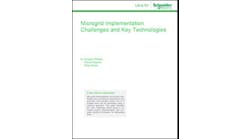It is hard to see the business sense in asking a company to sell less of its product. Yet, that is pretty much how the US handles energy efficiency.
Call it the great dilemma of energy efficiency: Utilities make their profits selling energy. Government asks them to sell less to achieve state energy efficiency goals.
“You are asking a for-profit company to hurt itself, and most for-profits are not going to do that,” said Ted Trabue, managing director of the District of Columbia Sustainable Energy Utility (DCSEU).
Is there a way to fix this?
Many experiments are underway, often involving financial sticks and carrots for electric and gas utilities. But Washington, D.C. has a different approach. The nation’s capital city has handed management of energy efficiency over to a separate entity, the DCSEU.
Formed in 2011, the organization has a mandate to save, not sell, energy. The organization focuses on efficiency in homes and buildings within the city borders.
The DCSEU also works on improving economic conditions within the city. And this gets at another dilemma, one faced by D.C. in particular.
About 70 percent of the jobs in the city are held by non-city residents. Many live in nearby Maryland and Virginia. This puts the city at an economic disadvantage. These workers do not pay income taxes back to the city. So D.C. officials are understandably keen on making sure revenue generated from city residents serves them.
The DCSEU is funded by gas and electric ratepayers in D.C. To ensure that city residents get the maximum advantage from the dollars, officials mandate that the organization supports DC companies and creates jobs for those who live within the city’s borders. DCSEU hires only D.C. residents and contracts locally for services.
The organization operated in 2013 under a $17.3 million budget, which rises to $20 million in 2014. It has used the funding for a range of programs, from distributing CFLs at city food banks to assisting with home retrofits and multi-family buildings projects. About 30 percent of its budget goes toward low-income residents. The DCSEU also offers rebates, incentives and technical advice to the commercial sector, which accounts for about 70 percent of city’s energy use.
The program has saved 50,000 MWh, enough power for 6,000 homes for one year, according to its 2013 annual report. It served 40,000 households and supported 400 jobs. The organization estimates that it has achieved lifetime economic savings of $80 million.
With the DCSEU running its program, Washington, D.C. won 7th place in this year’s city scorecard, issued by the American Council for an Energy-Efficient Economy. The DCSEU takes from the experience of Vermont Energy Investment Corporation, its lead partner, which has operated a similar program in Vermont for several years.
Now, like others achieving large, aggregated energy savings, the DCSEU is exploring the possibility of selling its energy savings into the PJM Interconnection’s wholesale capacity markets. If successful, the capacity sales could offer a new source of revenue for the program.
From a national perspective, the model used in D.C. could be replicated in other cities and states, particularly those dissatisfied with other solutions on the table to overcome the great energy efficiency dilemma — and for those hoping to parlay energy efficiency into economic development.
What do you think of the idea of a separate organization — not the utility — administering energy efficiency programs? Please join our LinkedIn group and post your thoughts.





